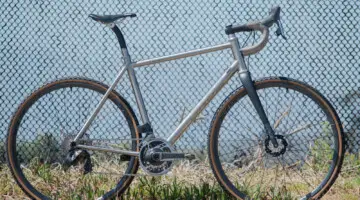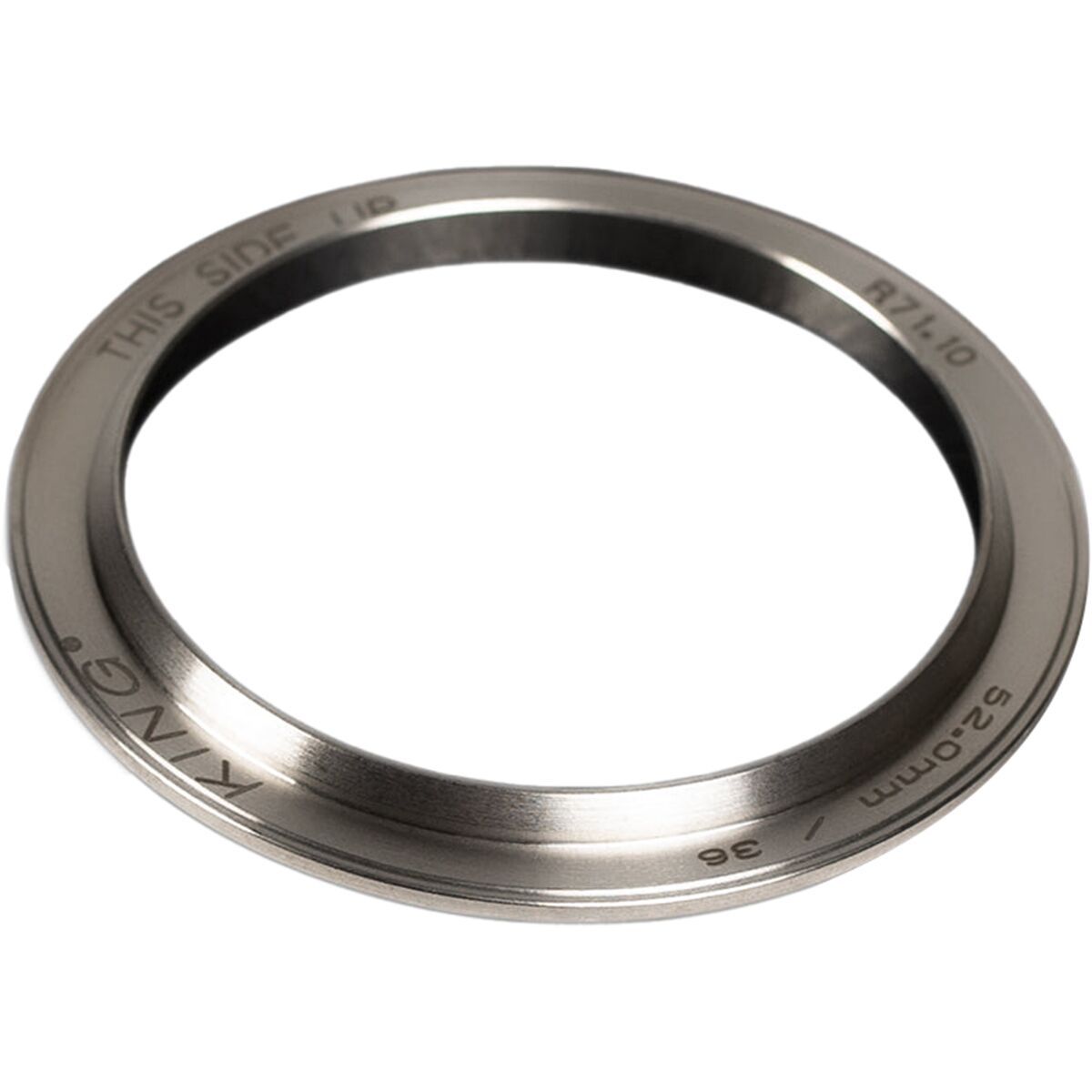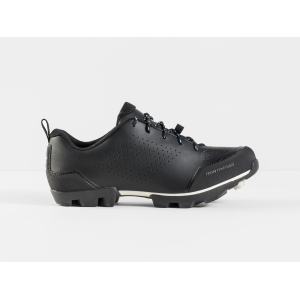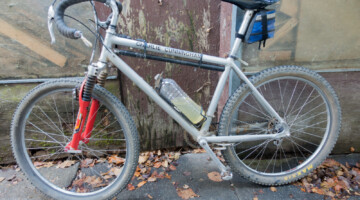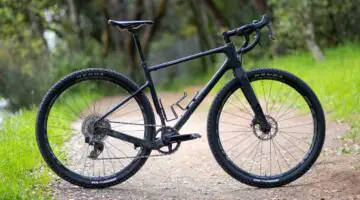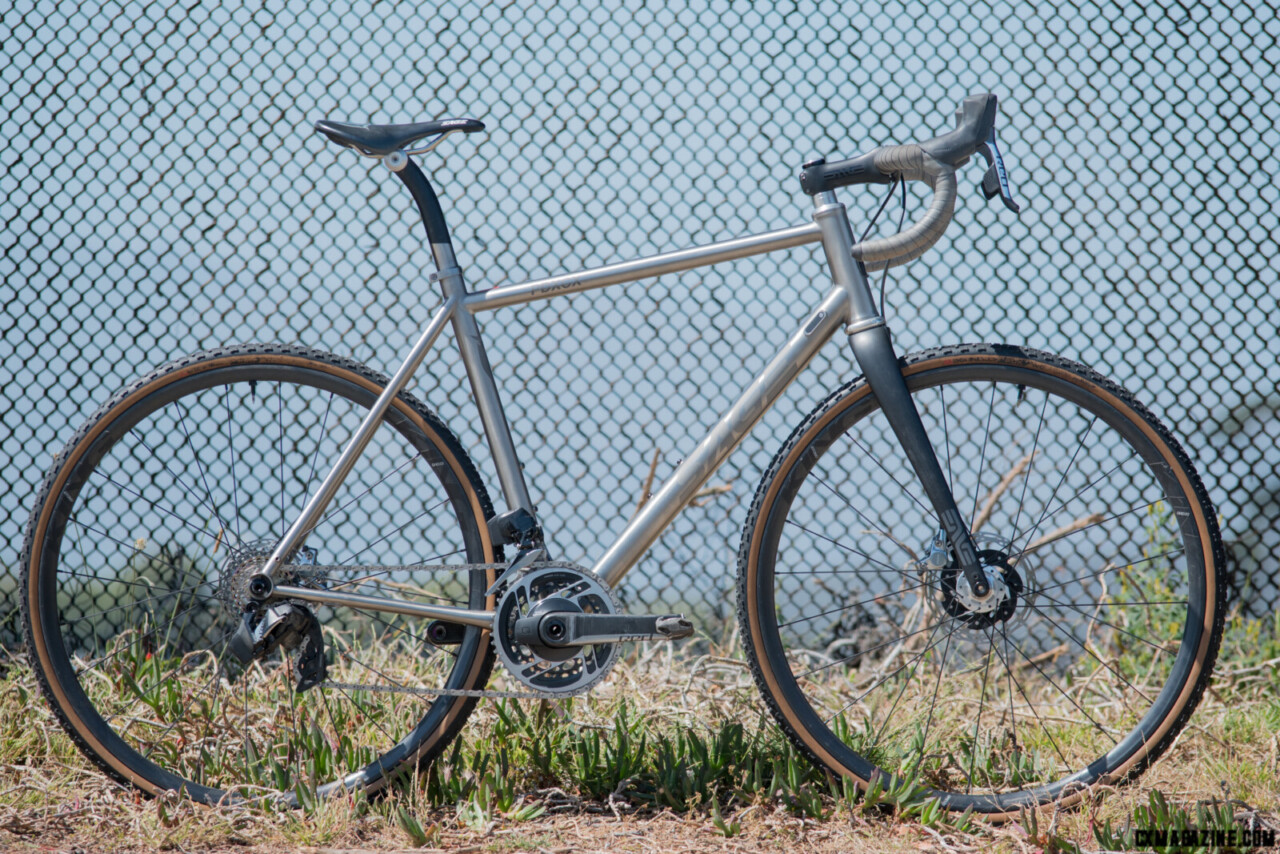
Sage Titanium PDXCX. ©C. Lee/Cyclocross Magazine
Cyclocross remains alive and well in the U.S., but gravel riding has grown into a larger—and still expanding—category. Major bike manufacturers, seeing only a limited market for cyclocross models in North America, have either scaled back or stopped importing and producing them altogether, reflecting market demand. You can race a gravel bike in a cyclocross event (and vice versa). Gravel bikes are typically designed for longer, less technical events, but some of us prefer them over cyclocross bikes for ’cross when they offer superior tire and mud clearance.
To understand the Sage Titanium PDXCX, let’s look briefly at the evolution of cyclocross bikes.
Cyclocross is a specific racing discipline and the ultimate under-bike event that predates mountain biking. Bikes are road-style with modifications for tire and pedaling clearance. The traditional European cyclocross bike has knobby tubular tires and a bottom bracket about a centimeter higher than a road bike for ground clearance, which is necessary because toe clips hung down during remount before the rider flipped them up to slide the foot in. Even with “clipless” pedals, the bike design stayed the same.
During the American Cyclocross boom of the early 2000s to about 2018, cyclocross bikes evolved for smoother and faster courses. Lower bottom brackets and slacker headtube angles made bikes feel faster on these courses.
This brief synopsis brings us back to the Sage Titanium Bicycles PDXCX. It is a 100% modern cyclocross-specific bike with every technological advancement available. However, the geometry is traditional European, with a relatively high bottom bracket and a relatively steep headtube angle.
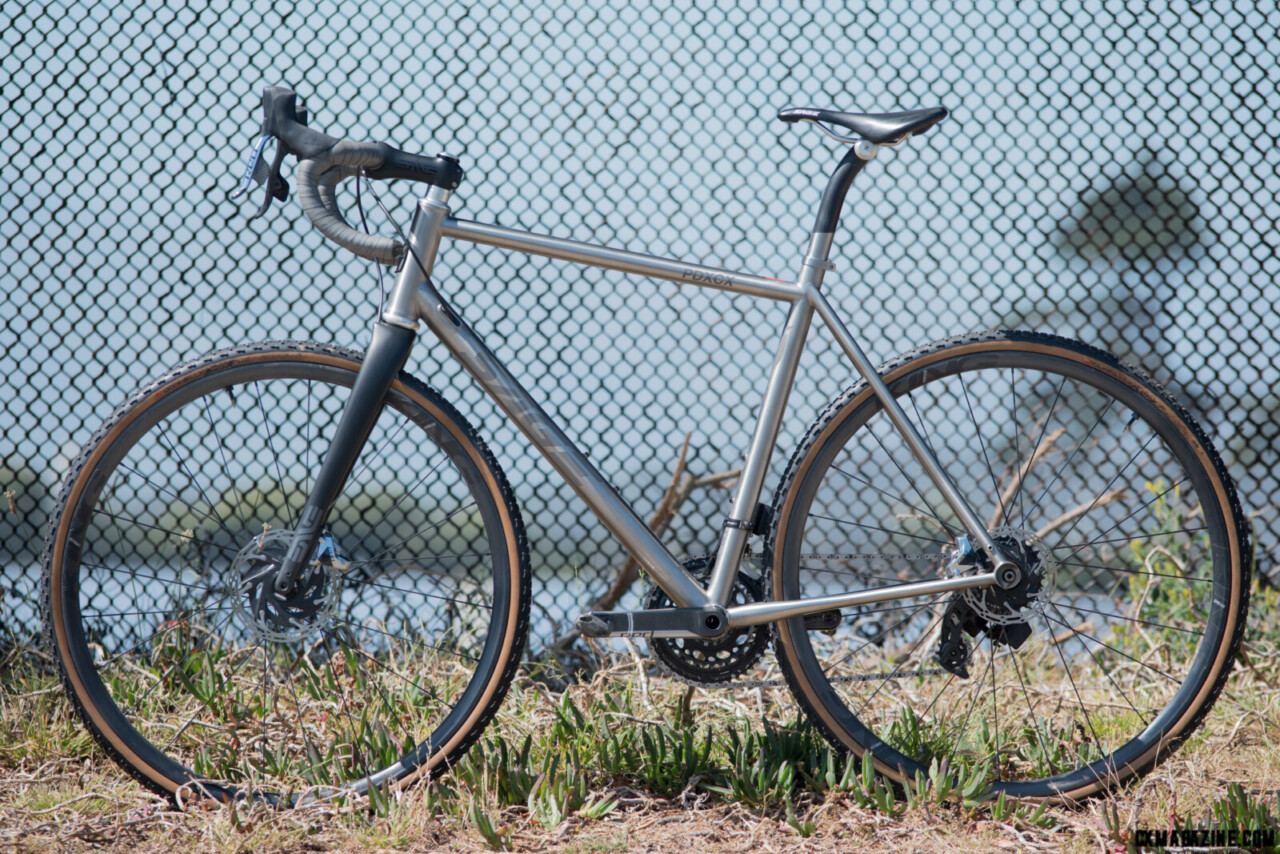
The clean side of the Sage Titanium PDXCX. ©C. Lee/Cyclocross Magazine
Sage Titanium
Sage Titanium Bicycles is a made-to-order titanium performance bike company with bike models for almost every cycling discipline. This includes two gravel models, one with an optional suspension-corrected geometry, three hardtail mountain bikes, a road bike, and the PDXCX cyclocross race bike we are reviewing.
David Rosen, founder and owner of Sage Titanium Bicycles, is deeply passionate about cyclocross racing—a love that’s embedded in his PDXCX design. A self-described cyclocross racer and all-night tinkerer, Rosen obsessively refines the PDXCX’s geometry to tackle technical terrain—from rocky Pacific Northwest trails to Belgian-style mud.
Sage Titanium bikes are entirely USA-made. Rosen works with a builder with custom titanium tubes and fixtures, including a 3D printed titanium chainstay yoke and rear fork ends. This business model is not uncommon in the bicycle industry.
The PDXCX Frame
Tube parameters such as diameter, manipulation of wall thickness, and material composition contribute to the ride quality of the bicycle. The PDXCX tubes are 2.5Al/3V titanium alloy, the most common alloy for titanium bicycle tubes. Rosen reviews DFARS certifications to ensure the highest quality available. Geometry and construction are also significant contributors to ride quality. David Rosen manipulates these two parameters to offer a signature Sage Titanium ride quality. His lifelong personal experience, experimentation, and some sponsored athletes’ contributions bring evolution to the Sage Titanium bike designs.
Sage Cyclocross Geometry
When David Rosen started Sage Titanium Bicycles in 2012, the PDXDX was a two-bike lineup. We’ve ridden and reviewed the original PDXCX in 2013 in our print magazine issue 25. That bike had IS mount disc brakes equipped with a remarkably high bottom bracket (a 5.5cm drop) and a short front center balanced with a slightly elongated rear end. We thought it was unique and even a bit quirky. Five years later, we rode and reviewed the evolved and refined version of the PDXCX with disc brakes. For the 2018 model, Rosen tweaked the geometry from the original’s unique parameters. That bike had a lower bottom bracket and longer front center. The formula worked, and Rosen has not changed the geometry of the PDXCX since then.
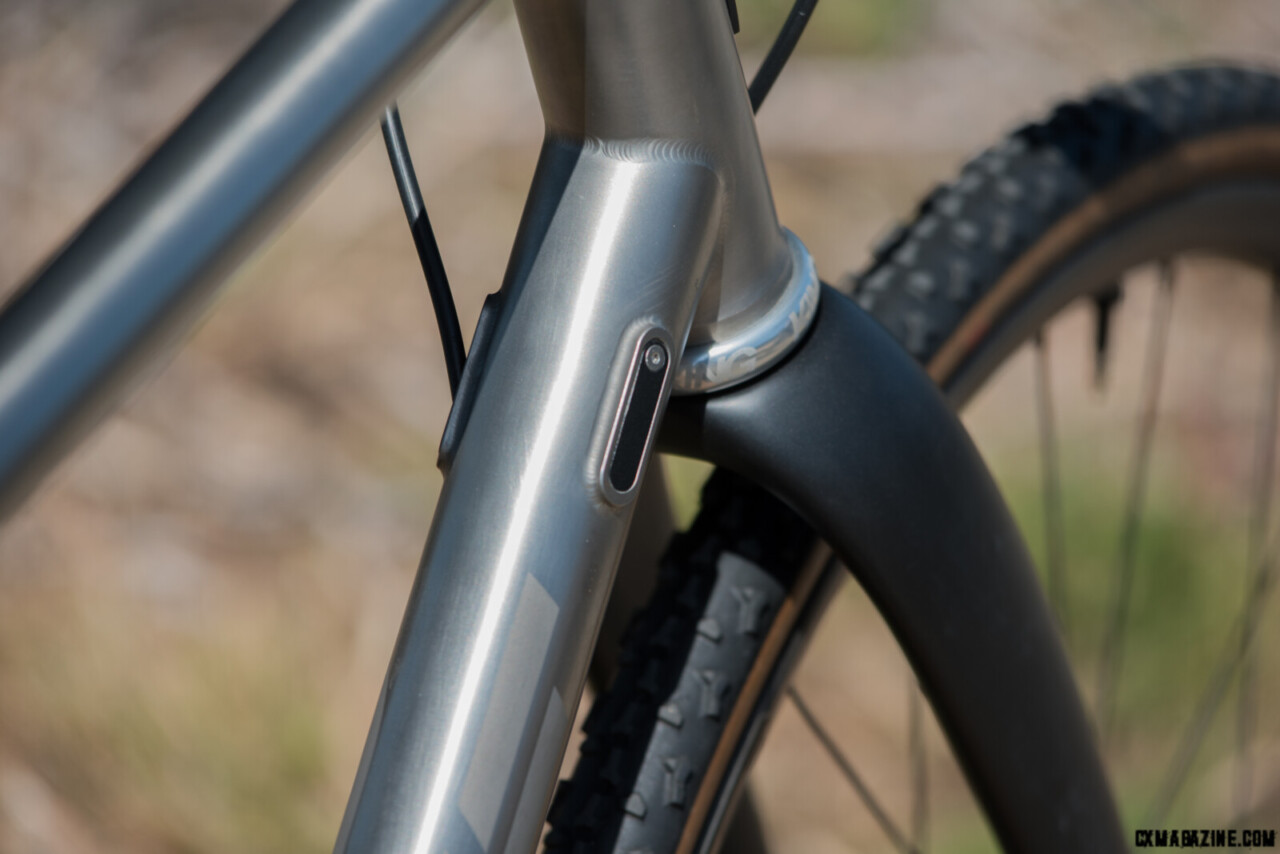
The Sage Titanium PDXCX has internal control lines. The weld quality is outstanding as showcased here. ©C. Lee/Cyclocross Magazine
What has changed is the tube supplier and builder. Rosen, always looking for improvement, sought higher tube quality control and build consistency. Consistent with that ethos, the new 2025 Sage PDXCX has 3D printed titanium frame components that our review model from a year ago does not. We saw these elements at Sea Otter 2025, and you can see them on his website.
View this post on Instagram
The 2025 PDXCX still has a 6.2cm bottom bracket drop for the middle of the size range. That parameter drops 2mm for the 2 smallest sizes and rises 2mm for the 3 larger sizes. The 42.5cm chainstay length remains a constant across the size range. The review bike is Rosen’s personal bike, which is a 56cm with stock geometry. He extended his headtube by 5mm to remove one spacer under his handlebar stem for aesthetics. You can see the complete geometry chart on the Sage website.
The 56cm PDXCX looks somewhat standard on paper. A 56cm effective toptube, 102cm wheelbase, 60.4cm front center, 590mm stack, and 385mm reach. The headtube angle Rosen chose is a bit steeper than you might find on the few US cyclocross frames available today. It’s 72.5 degrees on the 56cm frame and varies a bit by frame size. A standard 47mm offset cyclocross fork yields a road bike-like 60mm trail figure with a 33mm tire (58mm mechanical trail).
One parameter Rosen does not universally change is the tube gauge for each frame size. He encourages each buyer to have an in-depth conversation about their desires for bike use and ride quality, and he can offer parameter changes to achieve those desires. The seatstays have an S-shaped curve, and the chainstays are curved and flattened to clear the tire, and flattened in the opposite plane in the mid-section. Our 2024 model has a chainstay bridge behind the T47 bottom bracket. The 2025 model forgoes this feature.
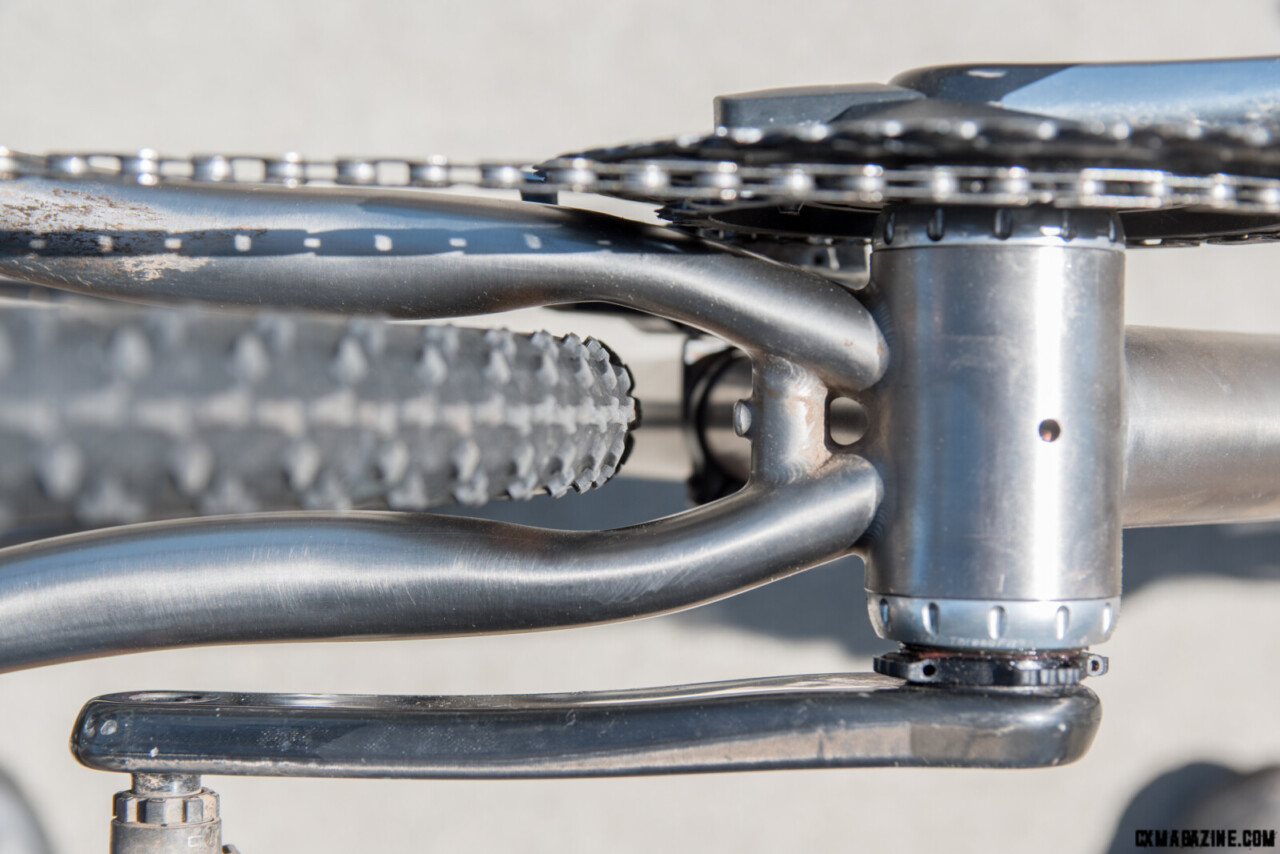
The 2025 version has a 3D-printed drive-side chainstay section, eliminating the bridge seen here. This shows a 33mm tire. ©C. Lee/Cyclocross Magazine
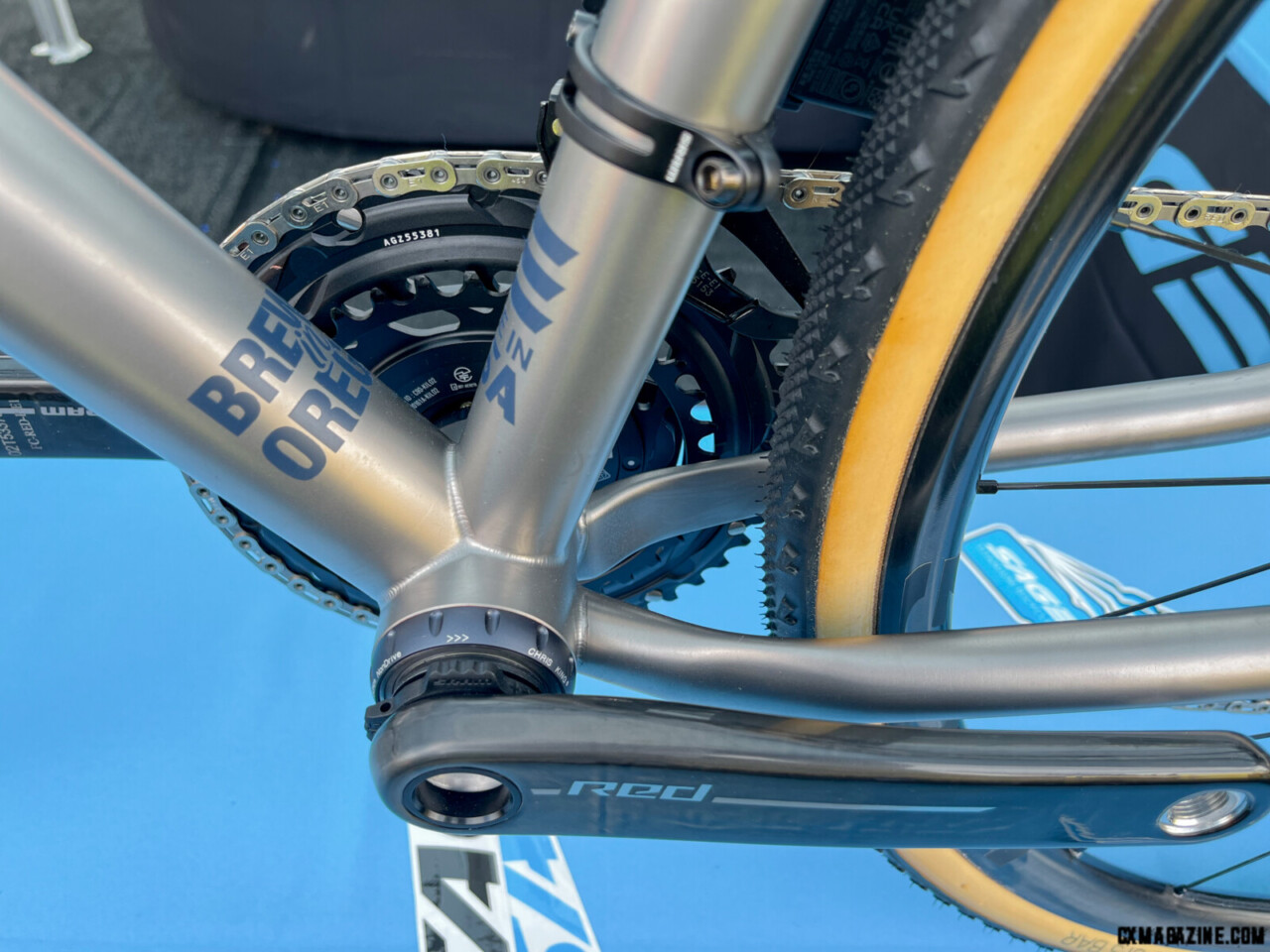
2025 Sage Titanium 3D printed drive-side chainstay yoke increases tire clearance. ©C. Lee/Cyclocross Magazine
The PDXCX uses internal control line routing, which enters the downtube. There is provision for cable-actuated controls using full cable housing runs. If you want to use a cable-actuated front derailleur, you must ask for that routing. This bike forgoes the cable front derailleur routing, but does have a port for a Shimano Di2 front mech wire. The rear brake hose exits the inside of the left chainstay to the brake caliper flat mount native for a 140mm rotor. The rear derailleur control cable (or wire) exits the bottom of the right chainstay ahead of the rear mech.
The down and seat tubes each have a set of standard bottle cage mounts. There are also fender mounts, but that is the extent of accessory mounts on this race-oriented machine. The frame has a standard 12mm X 142mm through-axle rear wheel mount. For 2025, the rear wheel mount has 3D-printed titanium ends.
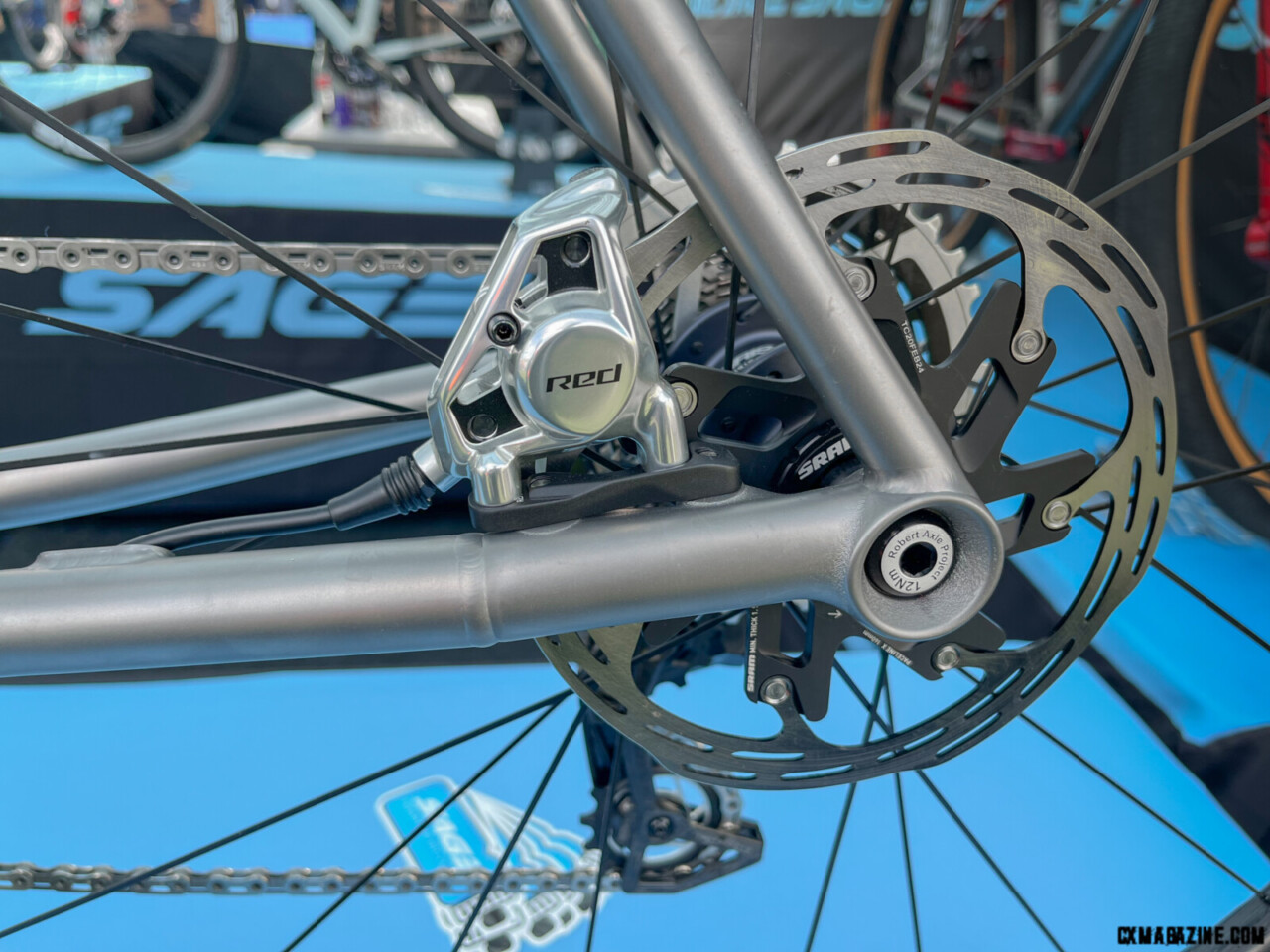
New 3D printed rear fork ends on the 2025 Sage Titanium PDXCX. That’s the new SRAM Red AXS E1 caliper on Rosen’s 2025 bike. ©C. Lee/Cyclocross Magazine
Rosen’s bike has an Enve 12mm X 100mm Gravel Disc fork with a 47mm offset and 395mm axle-to-crown distance. It has internal brake hose routing, fender mounts, and clearance for a 50mm tire. Enve no longer makes a cyclocross-specific fork.
The Sage PDXCX Build
This is David Rosen’s race bike; the component selection reflects his preferences. Major components are SRAM Red AXS 2 X 12-Speed. The 170mm SRAM Red AXS crank has a power meter with 46/33 T chainrings. The Red AXS cassette is 10-28 12-speed with 1-tooth jumps for the first 8 cogs. Shifting is completely wireless with SRAM Red eTap AXS front and rear derailleurs. The chain on this bike is SRAM Force 12-speed CN-SRC-D1 flat-top chain, rather than the new cut-out Force AXS version.
Brakes on this bike are SRAM Red ED D1, actuated by Red eTap AXS levers (EB-Red-D1). Rosen’s new bike has the latest E1 series brakes and levers.
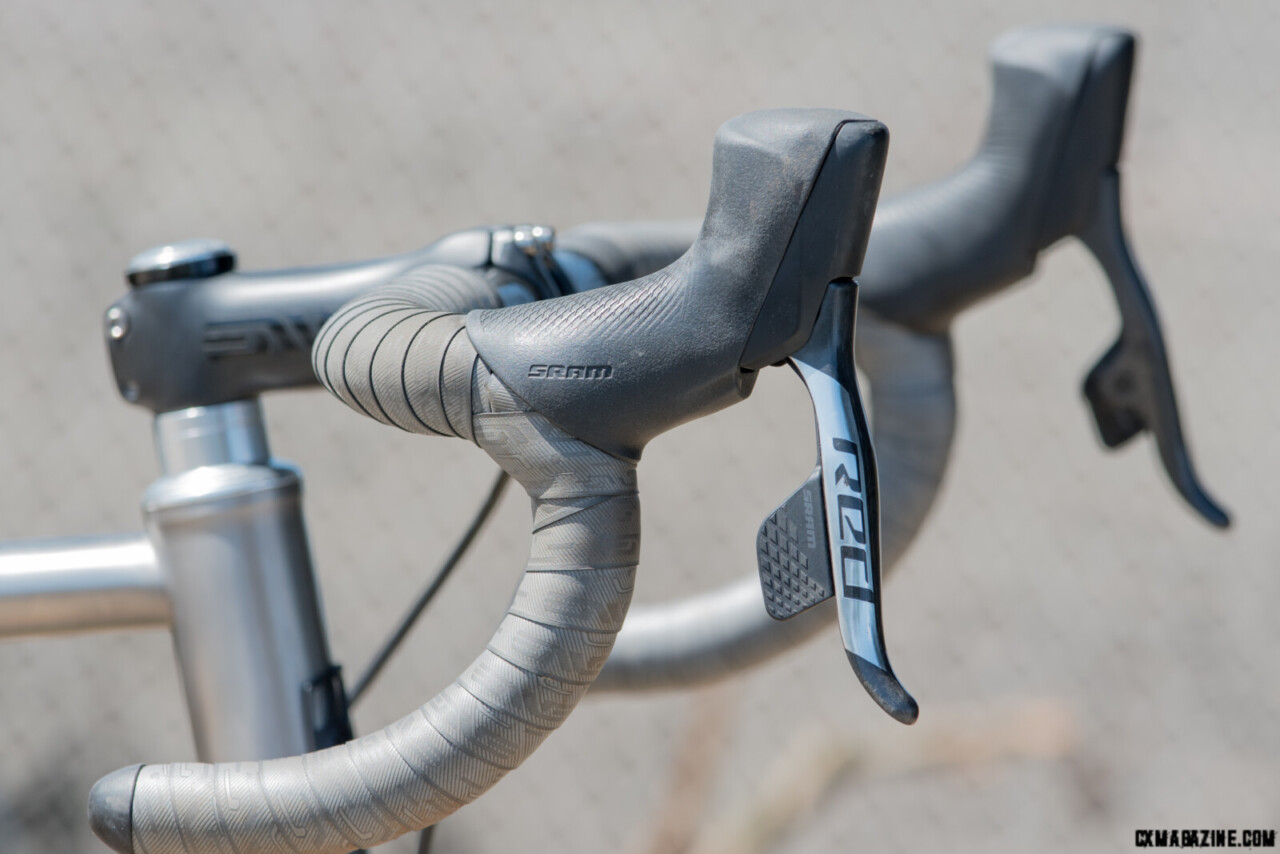
SRAM Red eTap AXS levers EB-Red-D1. ©C. Lee/Cyclocross Magazine
The handlebar and stem are Enve carbon. Rosen has a 10cm stem and 42cm handlebars wrapped with Enve bartape. The seatpost is titanium 31.8mm diameter with a custom cerakote finish.
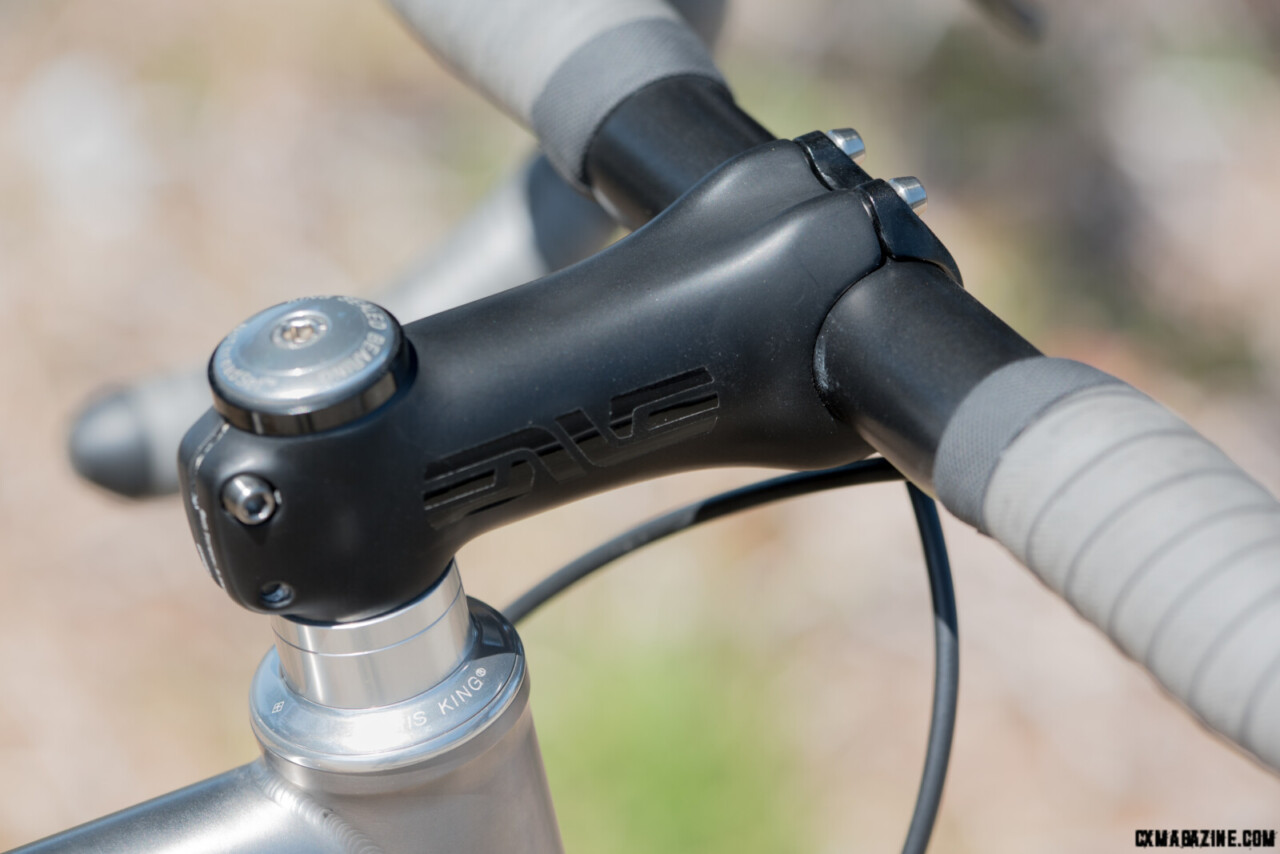
10cm Enve Stem. Chris King headset. ©C. Lee/Cyclocross Magazine
A titanium post in a titanium frame galls, so a fair amount of grease or anti-seize paste is needed. At least you’ll have confidence the post won’t slip.
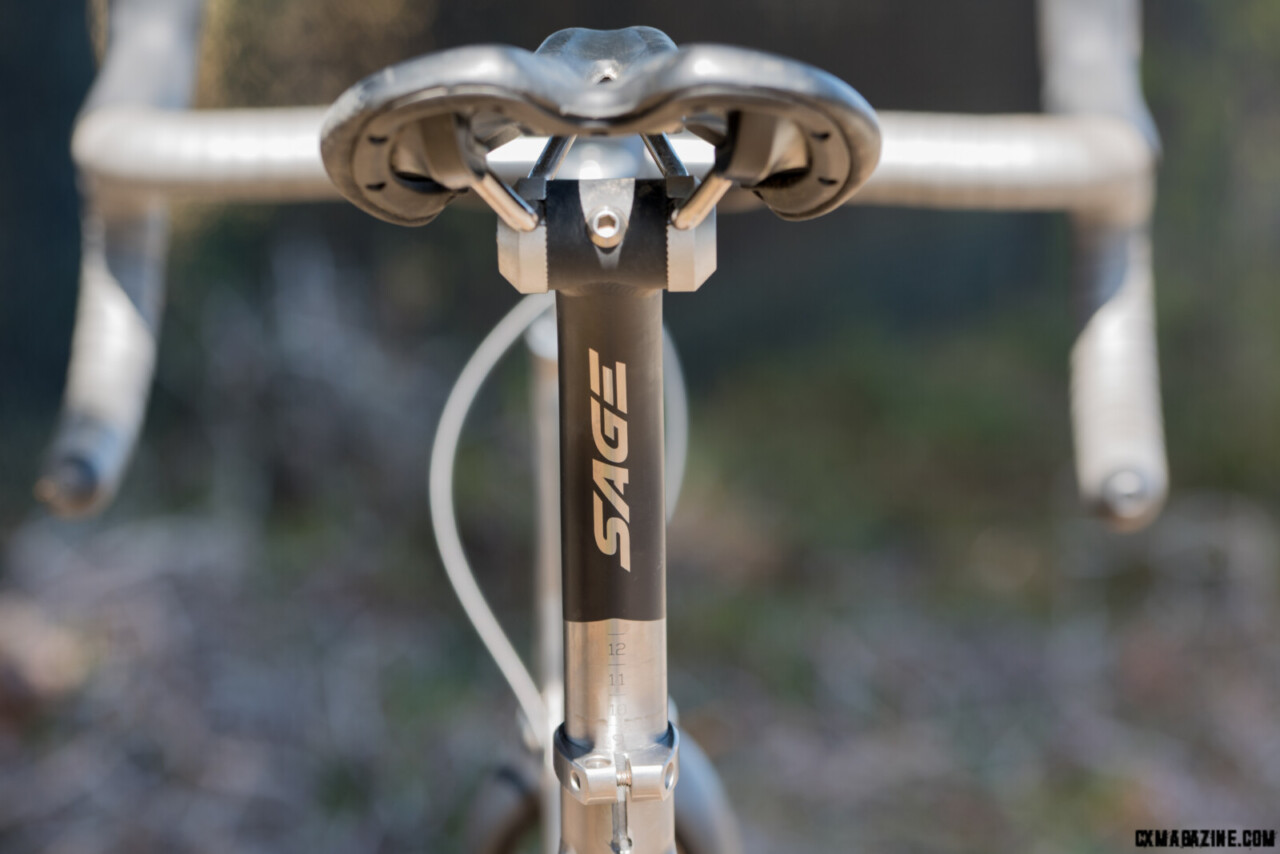
The finish on the top portion of the seatpost is Cerakote. ©C. Lee/Cyclocross Magazine
Bearings and Wheels
The bearing selection is Chris King in polished silver. That includes the headset, T47 external bottom bracket, and hubs. The PDXCX has a 68mm T47 bottom bracket shell, which is 68mm wide with a 46mm bore diameter. Threads are M47 X 1.0mm. The Chris King Threadfit 30 bottom bracket with external cups has a DUB adaptor kit. The 44mm inner diameter head tube has an InSet 5 for the tapered fork steerer tube.
The polished silver R45D hubs are the core of a Chris King GRD23 wheelset. The GRD 23 rim is recyclable thermoplastic from CSS Composites in Utah using FusionFiber® technology. The rims are 24mm deep with an internal width of 23mm hookless. The claimed weight of the wheelset is 1468 grams. 24-Pillar stainless blade spokes with alloy nipples lace the hubs to the rims with a X2 pattern for both the front and rear wheels.
A King Lifetime Warranty covers this wheelset. If you smash your rim, Chris King will rebuild your wheel with a new one, free of charge, for as long as you own the wheels.
SRAM Centerline XR rotors complete the wheels with 140mm on the rear and 160mm on the front.
Rosen has a pair of vintage Donnelly PDX WC (World Cup) 33mm tubeless tires on his bike. He has since switched to Dugast tubeless for cyclocross, but this pair of PDX tires is not even close to worn.
The Ride
Rosen’s personal Sage PDXCX is stock 56cm geometry except for a 5mm taller headtube. It just happens to be my size. Rosen has said, “You race a cyclocross bike…” That is referring to the intent of a ‘cross bike compared to a bike for multipurpose riding. The bike is built to Rosen’s personal preferences, and the frame geometry alone reflects that. However, his choice of a SRAM Red AXS double crank, gear selection, and tire choice are personal choices that you can change if you decide to order a Sage bike.
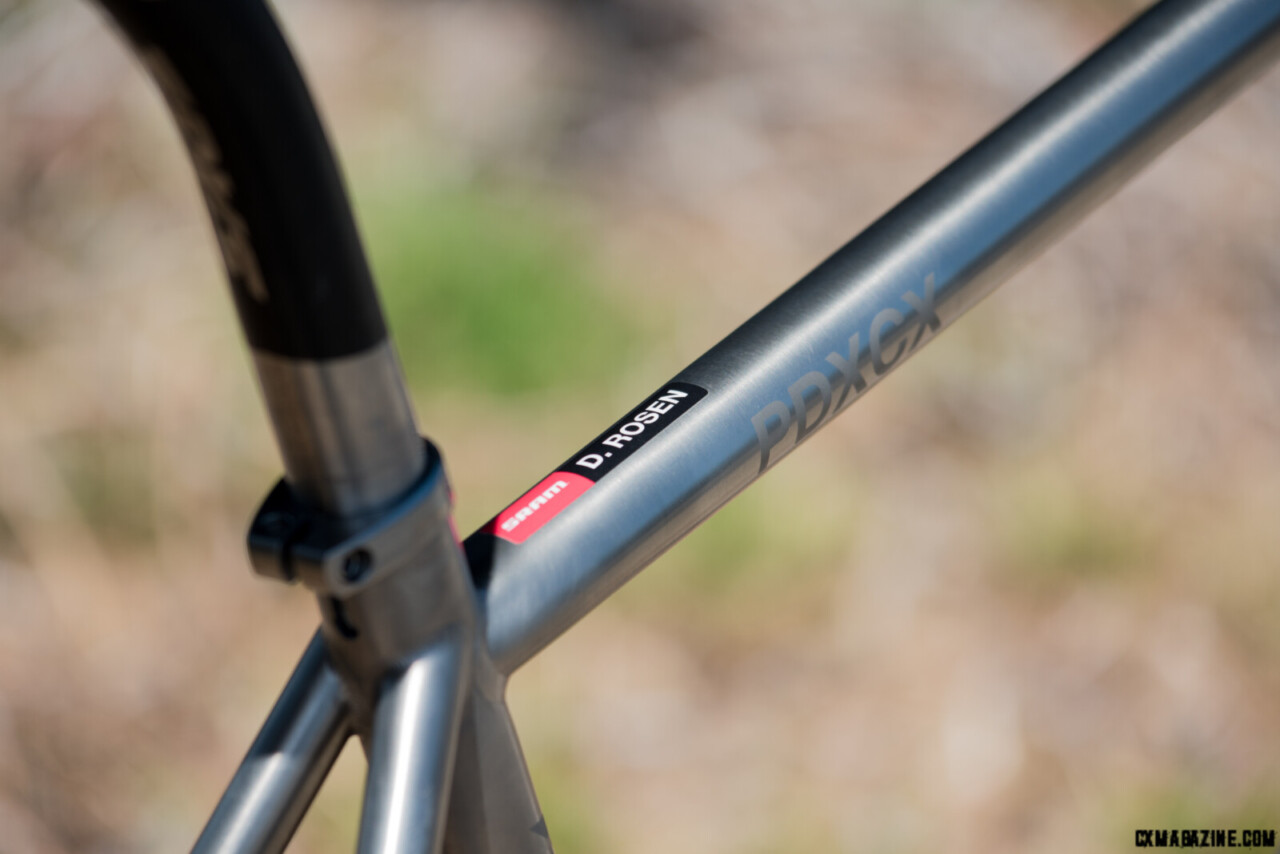
Sage Titanium PDXCX founder David Rosen’s personal bike. ©C. Lee/Cyclocross Magazine
Cyclocross Specific
I should remember that Sage Titanium has three gravel bikes in addition to the cyclocross-specific PDXCX. North American cyclocross courses are slightly different from the European cyclocross courses they are patterned after. Even European cyclocross courses vary, from the snow of Val di Sole to the sunshine of Benidorm, the sand of Koksijde to the mud of Dendermonde. Each enthusiast imagines the ideal bike differently.
Every bike takes a moment to get used to. Coming to the Sage PDXCX from other recent cyclocross and gravel bikes, I noticed that the saddle is about 1 centimeter higher above the ground. That’s initially when I swing my leg over, and perhaps it’s related to my hip inflexibility or personal sensitivity to bike geometry. It feels like getting on a mountain bike with the dropper post up. Other riders may barely notice the less than half-inch. This, of course, is from the higher bottom bracket of the PDXCX.
That extra BB height gives a bit more crank clearance from the ground. That is beneficial when pedaling on a steep off-camber, or if you lift the bike over an obstacle, or that one pedal stroke you need at the crest of a steep ride-up. The ground clearance is even better if you ride short cranks or a smaller chainring.
Once accustomed to mounting the bike, I hardly noticed the height difference, unless I’d ridden the same track on a bike with a lower bottom bracket right before or after the PDXCX. During a downhill turn, I feel higher. If I need to dab in a turn, my foot is a half-inch higher from the ground. It’s more of a psychological barrier than a physical one.
Regarding Rosen’s comment about racing, the bike feels like a racer with its steep headtube and low trail calculation. The stack is relatively high and the reach is short compared to the slacker, longer, and lower Sage Barlow Gravel race model. The PDXCX has geometric similarities to other cyclocross race bikes, such as the Bombtrack Tension-C from Germany and, in some ways (bottom bracket height aside), the Trek Boone, but is longer in reach. The PDXCX has the shortest trail calculation for the same tire size, lending its quick handling nature noticeable in tight chicanes through trees, or flat turns with good traction where a little body english gets you effortlessly around the turn.
The slightly shorter, higher position puts the rider’s weight a bit more over the bottom bracket, which I like in combination with the short trail. The differences are small, and the ride quality differences are subtle, though real in juxtaposition to another bike.
Cyclocross Tires Are Narrow!
Regarding tire clearance, the 2024 PDXCX we rode for review has a maximum clearance for 38mm tires, limited by the chainstays and chainstay bridge, which incidentally acts a bit like a mud shelf. The 2025 model forgoes the chainstay bridge, and with the 3D-printed right chainstay yoke, the tire clearance is increased to 40mm.
Rosen’s bike has 33mm 240tpi nylon-cased tubeless tires. These measure a true 33mm on the 23mm internal width Chris King GRD wheels. The Donnelley WC PDX tread is relatively thin with small, widely spaced knobs, which all contribute to a supple tire that is sensitive to small changes in tire pressure. On one hand, the supple tires make the ride smoother, on the other, the narrowness gets deflected by ground irregularities more easily (which increases rolling resistance) and offers less rim protection. It’s odd that cyclocross racers, when not in mud, still race on 33mm tires, when many road racers now use that width, but that’s a topic for a different article.
The Sage PDXCX has the iconic damped titanium ride. I had to ride with the same wheel and tire combination on another frame to confirm that. However, due to the tube parameters, construction, and frame geometry, the PDXCX feels snappy, both in acceleration and climbing, as well as steering and handling. For a ‘cross race, I don’t believe the PDXCX will be your limiter.
Component Selection
Rosen races with a double chainring setup. Some riders like a single chainring for ‘cross on punchy courses where small gear steps may not be so critical. Using a double chainring risks a chain drop when shifting the front, and the extra chain retention of a SRAM X-Sync™ wide-narrow tooth profile is not possible where the chain needs to shift between rings. However, the SRAM Red AXS rear derailleur has a silicone fluid-damping chain tension system, and Rosen put a chain guide on the SRAM Red AXS front derailleur to prevent an inboard chain drop.
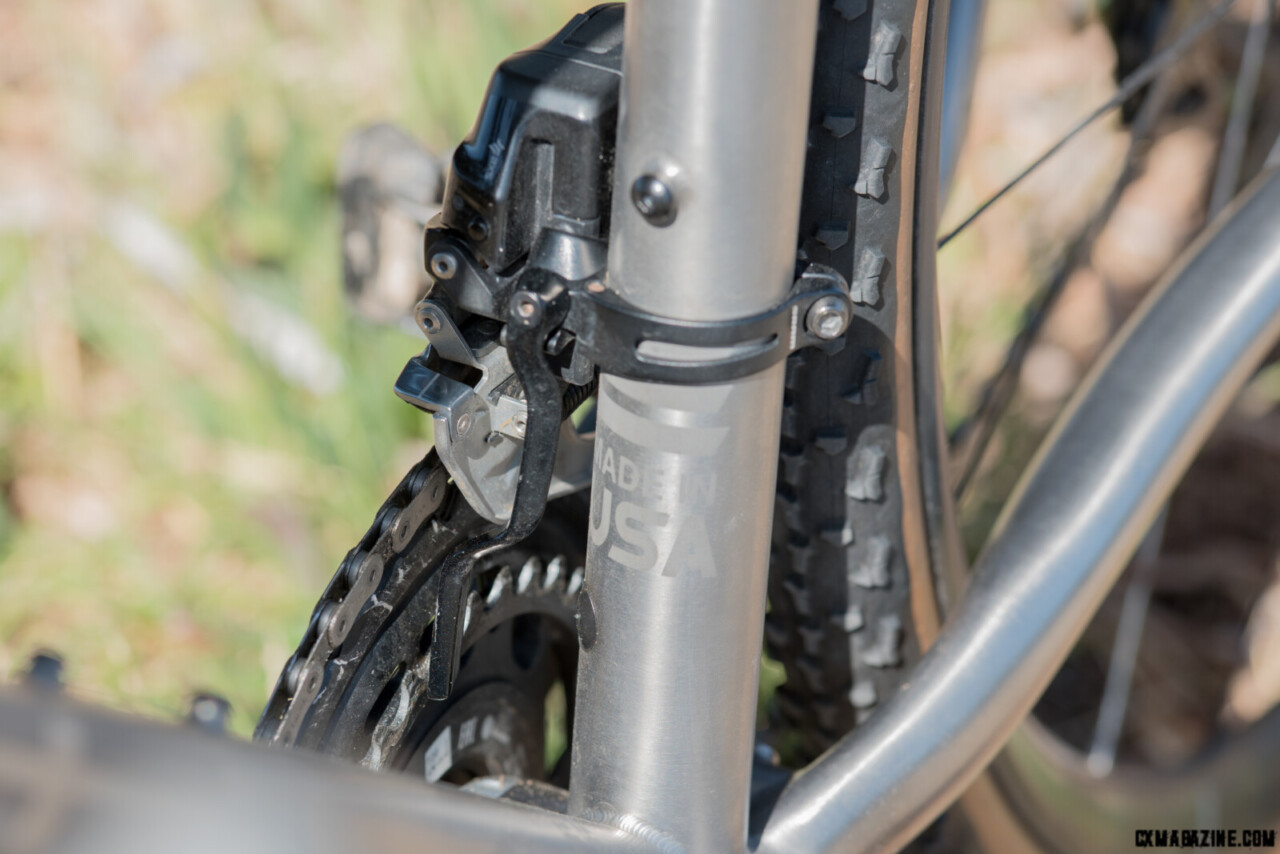
SRAM Red Etap chain Watcher. ©C. Lee/Cyclocross Magazine
The SRAM 46-33 chainring combination yields a fairly wide range for the 10-28 12-speed cassette. The cassette has one-tooth steps for the 8 smallest cogs. With that many gears, I’d rather spread the range out a bit and get a couple of lower gears, especially since I have a double chainring combination.
SRAM road brakes have improved in feel over the past generation. The system still uses DOT fluid, which is harder to work with and has greater hygroscopic properties than mineral oil systems for bicycles, which means fluid replacement intervals are greater in theory.
Buzz
The sound of a Chris King RingDrive rear hub is rather recognizable. The RD45 is a subdued version of the “swarm of bees” sound and smoother, with less drag, in my opinion. As much as some cyclists like a buzzy freewheel, that loud noise represents friction, which is energy loss. You will greatly appreciate the beautiful RD45 hub if you look down at your front hub as we all do with that hard effort! Otherwise, the 1500-gram wheelset is well made, and I appreciate the no-fault warranty and recyclability of the thermoplastic rim.
The Verdict
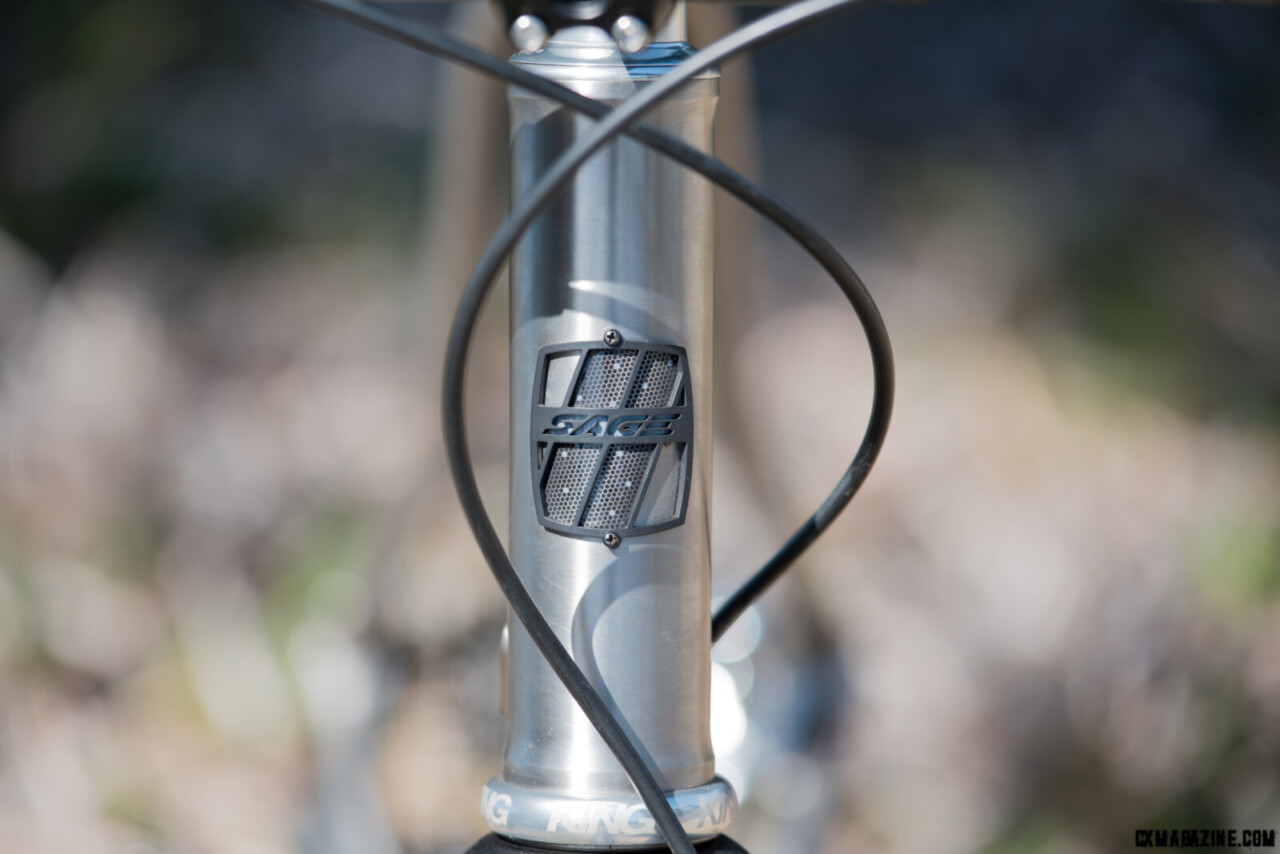
The Sage headbadge doesn’t help your CDa, but it sure adds panache. ©C. Lee/Cyclocross Magazine
Rosen’s personal race bike is decked out with the highest-end components. He prefers a traditional double chainring setup with a tight cassette and traditional 33mm cyclocross tires. None of that changes the core of the Sage PDXCX ride.`
I found the PDXCX refreshingly different on my familiar tracks. It shines in certain conditions where the course is fast and tight with ground irregularities like roots, small steps up or down, and off cambers. I did not like it on steep descents with surface irregularities. I’ve ridden so many low, slack gravel bikes that boost confidence in those conditions, but I was also biased by the narrow tires. All cyclocross bikes had high bottom brackets in the not-so-distant past, and we underbiked in the cyclocross off-season on narrow tires with worse brake control.
I’m glad Rosen makes the PDXCX. He embodies the ethos of a racer-bike designer: cycling isn’t just his business—it’s his lifestyle, and cyclocross is his canvas of experimentation and dedication.
If you’re looking for a cyclocross-specific steed, and don’t want it to double as a burly gravel racer, the Sage PDXCX is definitely worth a look. The titanium should be durable, rust proof and tolerate 45-60 minutes of weekly abuse.
More info: sagetitanium.com
Sage Titanium PDXCX
MSRP: USD 13,000* as tested
Frame: Sage 3Al/2.5V titanium alloy, 12 X 142mm through axle, T47 BB, SRAM UDH compatible
Fork: Enve G-Series, 12 X 100 through axle
Weight: 18 pounds as tested with no pedals; 12.6 lbs without wheels or pedals
Shifters: SRAM Red eTap AXS
Crankset: SRAM Red DUB Wide, 46-33 T, 170mm arm
Brakes: SRAM Red D1 flat-mount calipers, SRAM Centerline center lock rotors, 160mm front and 140mm rear
Cockpit: Enve 10cm stem, Enve compact 42mm width
Seatpost: Sage Titanium custom*, 36.1mm diameter (
Saddle: Sage Baccus, titanium rails
Wheels: Chris King GRD, 24 spokes
Tires: Donnelly PDX WC, 700C X 33mm
Warranty: Frame lifetime against manufacturer defects to the original owner.
Country of origin: USA










